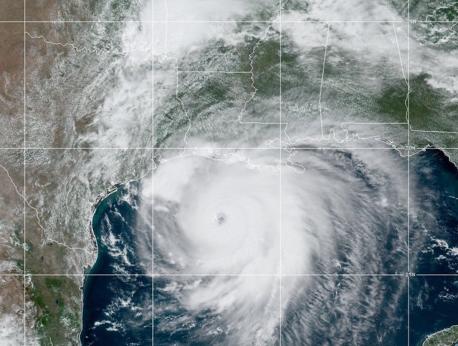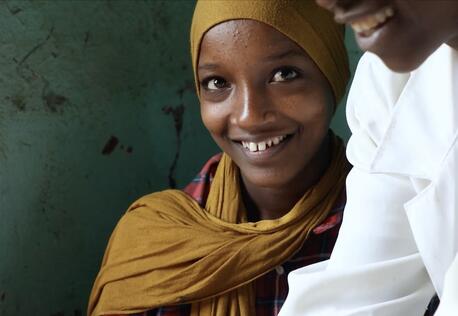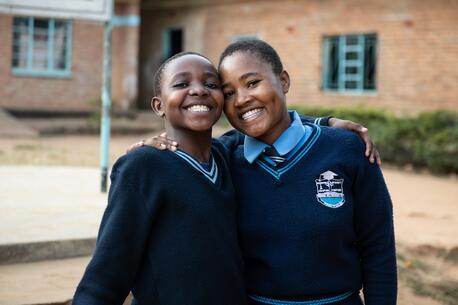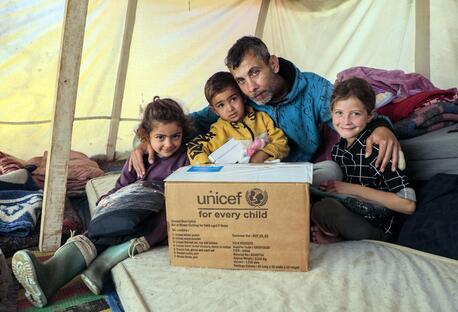
Gulf Coast Braces as Category 4 Hurricane Laura Nears
As the National Weather Service issues warnings of "catastrophic storm surge," UNICEF and partners are preparing to help as needed.
UPDATE August 27, 2020: Hurricane Laura swept ashore in Cameron, Louisiana about 35 miles from the Texas border early Thursday morning, August 27, with maximum sustained wind speeds of 150 miles per hour and a wall of water. Dangerous storm surge and flash flooding continue as Laura, now a Category 2, pushes inland.
More than 500,000 residents of coastal zones of Texas and Louisiana are under some form of evacuation order; hundreds of thousands have lost power. Search and rescue operations and damage assessment will begin as the storm subsides.
Hurricane Laura has intensified to an "extremely dangerous Category 4 hurricane" and will make landfall along the Texas/Louisiana border, the National Weather Service warned in a 1:00 PM bulletin on Wednesday, August 26. "Catastrophic storm surge, extreme winds and flash flooding expected along the northwest Gulf Coast tonight... Little time remains to protect life and property."
The NEXRAD radar data out of Lake Charles, LA shows #Laura's strong outer bands already pushing through southern Louisiana & east Texas, as well as a clear outline of the eye of the hurricane.
— National Weather Service (@NWS) August 26, 2020
This is a VERY dangerous storm. Monitor media for the latest from emergency management. pic.twitter.com/SoUfgYisrt
Laura is expected to be the most powerful storm to hit the U.S. this year. The storm surge could reach as far as 40 miles inland. "It looks like it's in full beast mode," University of Miami hurricane researcher Brian McNoldy told CBS News. "Which is not what you want to see if you're in its way."
Calling the storm "unsurvivable," authorities are urging coastal residents to evacuate. COVID-19 is presenting a serious complicating factor; evacuees are being transported in half-empty buses as far as three hours away from the storm's predicted path and housed in motel rooms instead of crowded shelters.
Hurricane Laura is expected to be the most powerful storm to hit the U.S. this year
UNICEF is monitoring the storm's impact and reaching out to current and potential partners — including the Louisiana Partnership for Children and Families, Agenda for Children, Children's Coalition for Northeast Louisiana and Boys and Girls Clubs of Louisiana — to organize a potential response. When Hurricane Harvey slammed into Texas and Louisiana in 2017, killing more than 75 people and causing billions of dollars in damage, UNICEF was on the ground, working with partners to provide counseling services for traumatized children and deliver educational materials to students whose schools were damaged or destroyed.
Top photo: An image from the National Hurricane Center showed Hurricane Laura approaching the Gulf Coast on Wednesday, August 26, 2020. © NOAA
HOW TO HELP
There are many ways to make a difference
War, famine, poverty, natural disasters — threats to the world's children keep coming. But UNICEF won't stop working to keep children healthy and safe.
UNICEF works in over 190 countries and territories — more places than any other children's organization. UNICEF has the world's largest humanitarian warehouse and, when disaster strikes, can get supplies almost anywhere within 72 hours. Constantly innovating, always advocating for a better world for children, UNICEF works to ensure that every child can grow up healthy, educated, protected and respected.
Would you like to help give all children the opportunity to reach their full potential? There are many ways to get involved.





